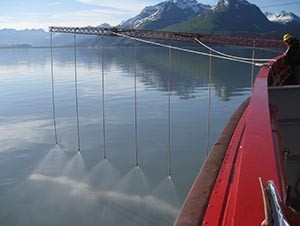
Published 4/14/2015:
The Environmental Protection Agency is updating the rules for using chemicals, including dispersants, when responding to oil spills in the United States. The update is intended to address the concerns which arose after the BP Deepwater Horizon disaster in 2010. During that disaster, an estimated 210 gallons of oil was spilled, and over 1.8 million gallons of dispersants were applied to the spill.
The EPA is seeking public comments on these proposed changes. The council thinks that this opportunity to comment on these changes is a rare and important event, and we would like to encourage you to add your voice to the public comments.
To help you understand the issues and provide your own comments, the council has prepared an overview of our comments.
What are dispersants?
Chemical dispersants are substances applied to spilled oil with the goal of dispersing the oil into the water column rather than leaving it floating on the surface in a slick.
The council has long been concerned about the use of chemical dispersants as an alternative spill response method. Mechanical recovery (removing oil using equipment) should take priority over the use of dispersants. After years of promoting research and testing to increase knowledge about dispersants and the environmental consequences of their use, the council in 2006 adopted a position against the use of dispersants in the Exxon Valdez oil spill region.
What is Subpart J and why does it exist?
Specifically, the EPA is updating a document titled “Subpart J” also known as “Use of Dispersants and Other Chemicals.” This document is part of the National Oil and Hazard Substances Pollution Contingency Plan.
Subpart J governs the use of dispersants and other chemical and biological agents when responding to oil spills. Basically, it is a catalog of chemicals that have been vetted by the EPA to treat oil spills. Subpart J also spells out where dispersants can be used, and how much may be used.
The EPA wants to hear from you by April 22, 2015
The EPA is seeking public comments on its proposed revisions to Subpart J, and has provided a summary of the revisions along with a history of the document . All of this information can be found on the EPA webpage: Revisions to the National Oil and Hazardous Substances Pollution Contingency Plan; Subpart J Product Schedule Listing Requirements.
Overview of the council’s comments
- Summary of Comments on Subpart J – a brief summary and analysis of the key issues identified by the council regarding Subpart J
- Why PWSRCAC Does Not Support the Use of Chemical Dispersants – a short summary of issues regarding dispersants and their various effects on the marine environment and the sealife that lives in that environment
- FINAL version of complete council comments on Subpart J (large file, load time may be slow)
Questions?
Have questions or want to discuss this information further? Please contact council project manager Joe Banta at 907.277.7222.
More about dispersants and our years of research are available here: Oil Spill Dispersants